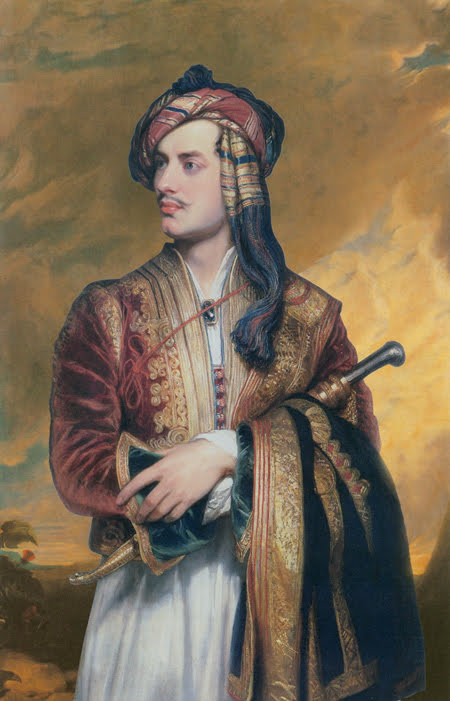George Gordon, Lord Byron

B is born on January 22 in London to Catherine Gordon, a Scottish heiress, and Captain John "Mad Jack" Byron. He is officially named George Noel Gordon, for, as part of their marriage arrangement, his father took his mother's family name.
B is taken by his mother to Aberdeen, Scotland. They live above a perfumers's shop. His father is mostly absent, returning occasionally to beg money from his wife. B and his mother are destitute.
B's father dies in France, possibly a suicide.
B enters his first school, in Aberdeen.
B attends Aberdeen Grammar School. In 1794, on the death of his great-uncle, he becomes heir to the title Baron Byron of Rochdale.
B is titled Lord B and moves with his mother to Newstead Abbey, ancestral home of the Byrons.
B attends Harrow School. In 1803, he falls his love with Mary Chaworth, his neighbor at Newstead. She rejects him.
B enters Trinity College, Cambridge. He is popular and makes several devoted friends.
His first volume of poems, Fugitive Pieces, is privately printed. Upon the Reverend John Beecher's objections to some of the poems, B withdraws the volume.
Poems on Various Occasions, an expurgated version of Fugitive Pieces, is privately printed. Later in the year the volume appears in a public printing as Hours of Idleness.
13 March: B takes his seat in the House of Lords.
Hours of Idleness receives a scathing critique in the Edinburgh Review. On July 4, B receives his A.M. degree from Cambridge.
B responds to bad reviews with English Bards and Scotch Reviewers. On July 2, he sails from Falmouth for Lisbon with his friend John Cam Hobhouse. They travel through Portugal, Spain, Malta, and Albania, reaching Athens at the end of the year. B writes the first Canto of "Childe Burun" (later Childe Harold's Pilgrimage).
Continues to travel through Greece and Turkey. On May 3, B imitates Leander and swims the Hellespont from Sestos to Abydos. He writes the second canto of "Childe Burun".
B returns to England on July 14. His mother dies soon after, as does his friend John Edleston ("Thyrza").
B delivers speeches in the House of Lords. Childe Harold's Pilgrimage, cantos I and II, published in March. B meets his future wife for the first time. He has a scandalous affair with Lady Caroline Lamb. He has another affair with the Countess of Oxford. He has another affair with Lady Webster.
Publication of The Giaour (June) and The Bride of Abydos (December). Some biographers believe he begins an affair with his half sister, Augusta Leigh, but the "evidence" is vague.
Publication of The Corsair (January) and Lara (August). Augusta's daughter, Elizabeth Medora, is born and later claims B is her father. B becomes engaged to Annabella Milbanke.
B marries Annabella on January 2. Publication of Hebrew Melodies. Daughter, Augusta Ada, born to B and Annabella on December 10.
B's wife leaves him in January. The Siege of Corinth and Parisina are published in February. In April the separation from his wife is formalized. B leaves England forever on April 24. Arriving in Geneva, he befriends Percy and Mary Shelley and Claire Clairmont, spends the summer with them, and has an affair with Claire. He then travels to Venice and has an affair with Marianna Segati, his landlord's wife. At the end of the year, Childe Harold's Pilgrimage, canto III and The Prisoner of Chillon are published.
B's daughter, Allegra, is born to Claire Clairmont on January 12. B travels to Rome with Hobhouse and returns to settle in Venice. He has an affair with Margarita Cogni, wife of a Venetian baker. He sells Newstead Abbey. Manfred is published in June.
Beppo (a satire in the ottava rima of Don Juan) is published in February. The Shelleys come to Italy and are with B from March to November. Childe Harold's Pilgrimage, canto IV is published in April. B's daughter Allegra comes to Venice. She is eventually sent to a convent.
B begins an affair with the married Countess Teresa Guiccioli. Mazeppa is published in June, Don Juan, cantos I and II in July. B moves to Ravenna at the end of the year to be near Teresa.
B lives in the Guiccioli palace with his daughter Allegra, Teresa and her husband. He becomes involved in the Carbonari movement, the Italian revolution against Austrian rule. Teresa and her husband officially separate in July.
Teresa's family, the Gambas, are banished to Pisa after the defeat of the Carbonari movement; B moves there with them. Marino Faliero is published in April, Don Juan, cantos III-V in August, Cain, The Two Foscari, and Sardanapalus in December. B promises Teresa to discontinue Don Juan.
Allegra dies in April. Leigh Hunt moves to B's house in June, where they collaborate on the journal The Liberal. Shelley is drowned on July 8 in his boat, the Don Juan. The Vision of Judgment appears in The Liberal in October.
Don Juan, cantos VI-XIV is published. B sails for Greece, arriving at Missolonghi on December 30.
Don Juan, cantos XV and XVI are published in March. 9 April: B catches a chill in the rain. 19 April: He dies at Missolonghi. In June, B is buried in Hucknall Torkard Church, near Newstead Abbey. His memoirs, which he intended for publication after his death, are burned by a group of his friends.